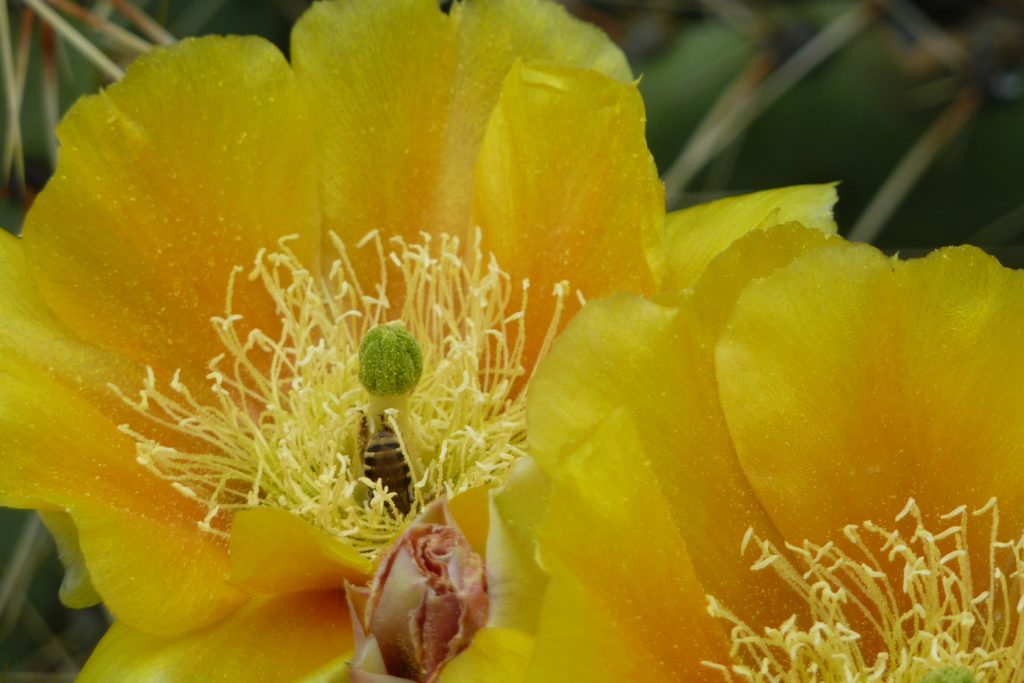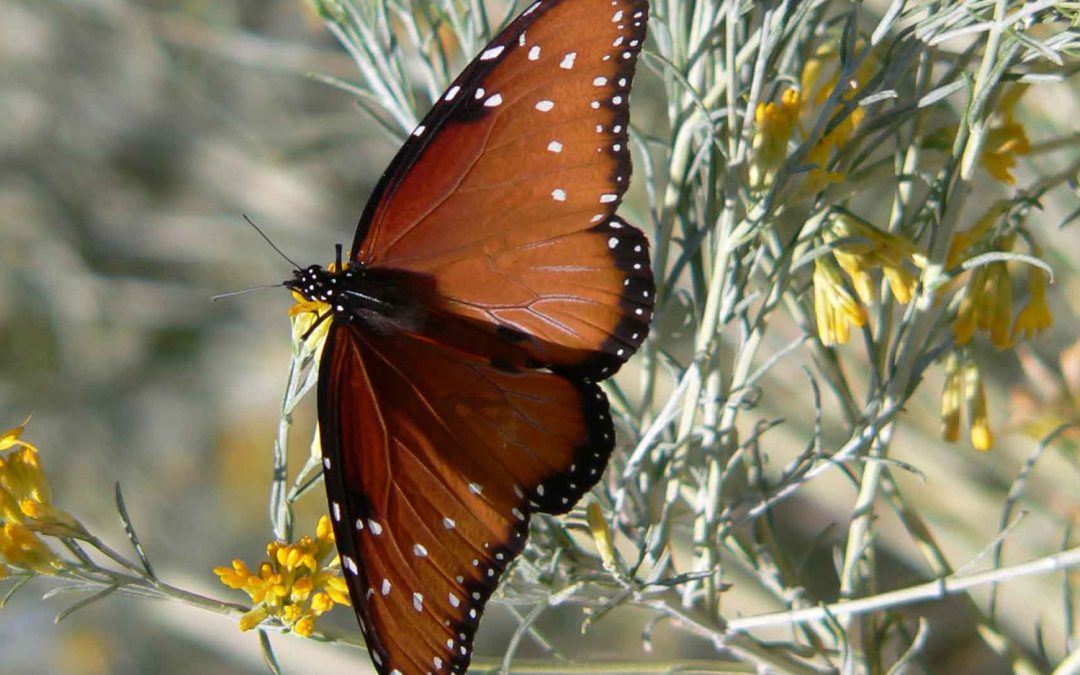Everything in nature is connected. Fostering the connections keeps ecosystems and gardens vital. And weaving pollinator essentials together into a beautiful garden is a fun process. Start by thinking about where you will view the garden from as well as how you’ll move through the space to view pollinator activity without disrupting your winged guests. Organize the largest and thirstiest plants around rainwater harvesting opportunities such as gutters or canales, and use pathways to divide larger spaces into smaller planting areas like herb gardens, wildflower beds and native shrub borders. Include the essentials of food, shelter and water in your garden and your pollinators will thrive.
Among the insects and birds that pollinate plants, bees are the primary work force. There are 1000+ kinds of native bees in New Mexico, as well as honey bees that assist plants in producing seeds. Butterflies and moths are less efficient pollinators than bees, and many have key relationships with specific plants: Monarchs butterflies with milkweeds and hawkmoths with evening primroses. Beetles, bats and hummingbirds are also nectar drinkers and pollinators.
Plants expend energy to produce showy flowers to attract pollinators. In exchange for distributing the pollen needed to fertilize the flowers so the plants can reproduce, the pollinator feeds on the energy-rich nectar. The shapes and colors of flowers determine who will pollinate them. Butterflies can’t hover to feed, so they need open-faced flowers with places to land, like daisies and roses. Hummingbirds and hawkmoths are able to hover while they probe tubular flowers for their nectar and pollen. Plants with inconspicuous flowers are often wind-pollinated, like native grasses, but are still part of the pollinator support system. Their leaves feed many larval stage insects.
If you are new to the neighborhood, survey plants nearby for pollinator activity and plant some of the busiest ones. If you already have plants in your garden that are abuzz with pollinators, think about replacing any plants that are shirking their habitat role with ones that are better hosts. Choose plants that are rich in nectar and well-adapted and watch your garden become a surprise party buzzing with energy.
- Food sources include flower nectar for sugar and essential amino acids, pollen for protein, and leaves as larval food. Native grasses are especially valuable as caterpillar food. Plan to include food sources throughout the seasons that pollinators are active.
- Shelter includes layers of canopy from taller trees, mid-height shrubs and groundcovers (knee high and shorter). Leave some dead snags as hummingbird roosts and for bee nesting. Leave leaf litter in some places and keep some open soil in out of the way areas for ground nesting insect habitat. Cluster plants in masses of varied heights and densities as cover. Plans for bee hotels and ready-made bee and bat nesting boxes are easy to find and build. Check nature center gift shops and online for ready-made nesting boxes.
- A small, trickling water feature as a source of drinking and bathing water for insects and birds should have shallow edges to avoid drowning bees. An extra drip emitter in fine stone mulch or bare ground is a good water source for bees and puddling place for butterflies.
- Eliminate pesticides and herbicides. You don’t wan to attract pollinators just to poison them! Your health will benefit, too.
The greater the variety of plants, the greater diversity of pollinators will visit. Plant for a seasonal progression of blooms. It takes at least 100 sq. ft. of the same flower to consistently attract pollinators (think a 5-foot-tall and wide fernbush or butterfly bush or a 10-foot x 10-foot wildflower or herb bed space). So if your neighbor has a swath of red valerian, plant a few but use more of your space for sunflowers, mistflower, yarrow, beebalm, salvias, penstemon, oregano, fennel, whorled butterfly weed or native buckwheats. Pollinators don’t recognize property lines so the more neighbors who garden for pollinators, the richer your neighborhood will become in pollinators. Avoid hybrid flowers, especially varieties with double flowers since those plants may produce little or no nectar or pollen.

There are public pollinator gardens in Albuquerque:
- Rio Grande Botanic Gardens on Central Ave at New York NW
- El Oso Grande Pollinator Habitat at the east end of El Oso Grande Park on Osuna Road @ Morris NE
- Albuquerque Garden Clubs Garden Center in Los Altos Park on Lomas just west of Eubank

Author: Judith Phillips, owner of Design Oasis, landscape designer and garden writer with 30 years experience designing arid-adapted and native gardens in the high desert.

